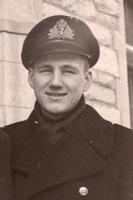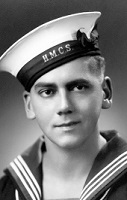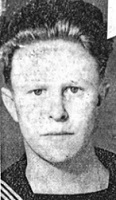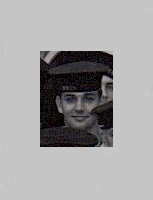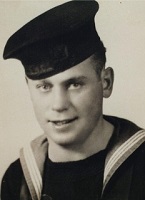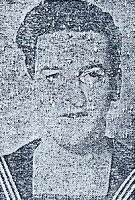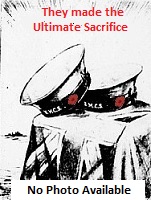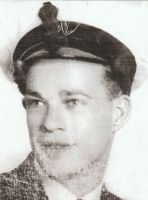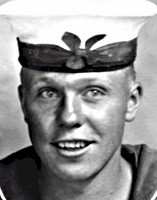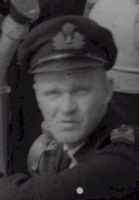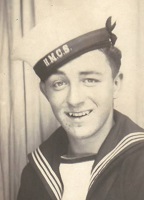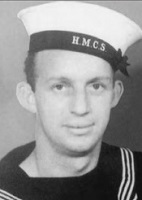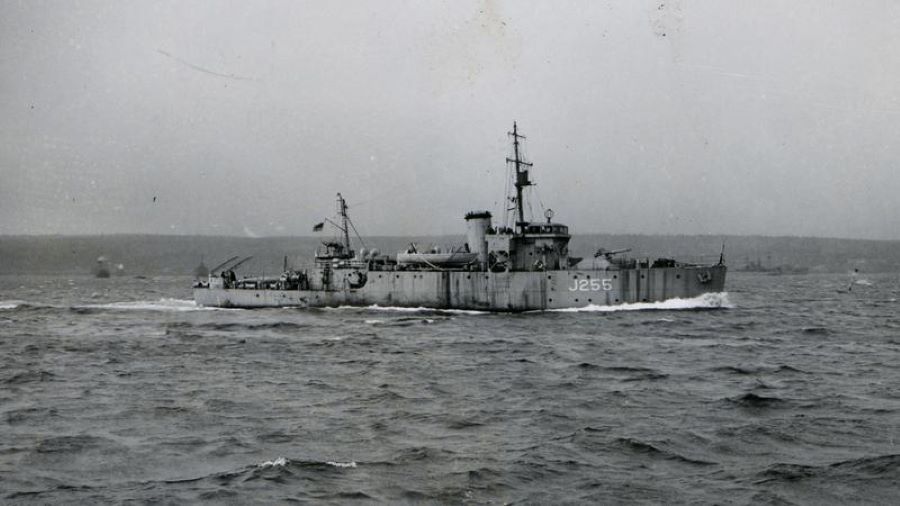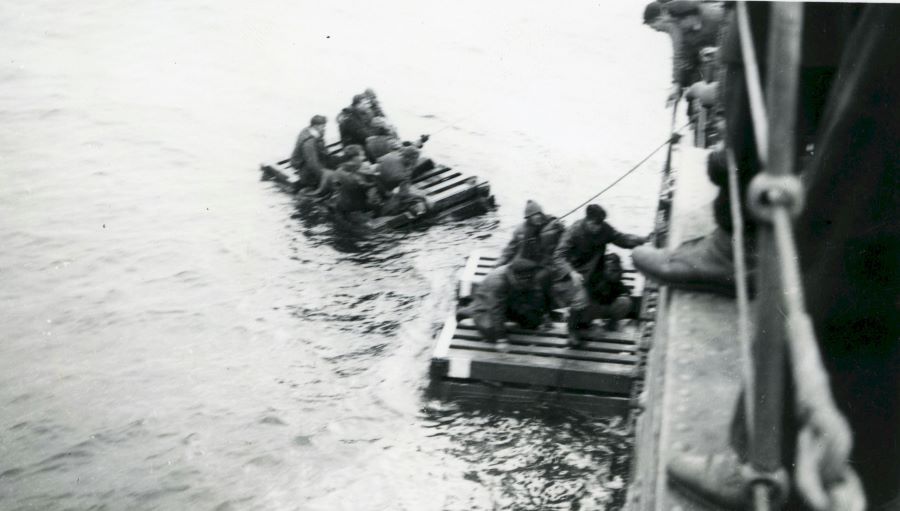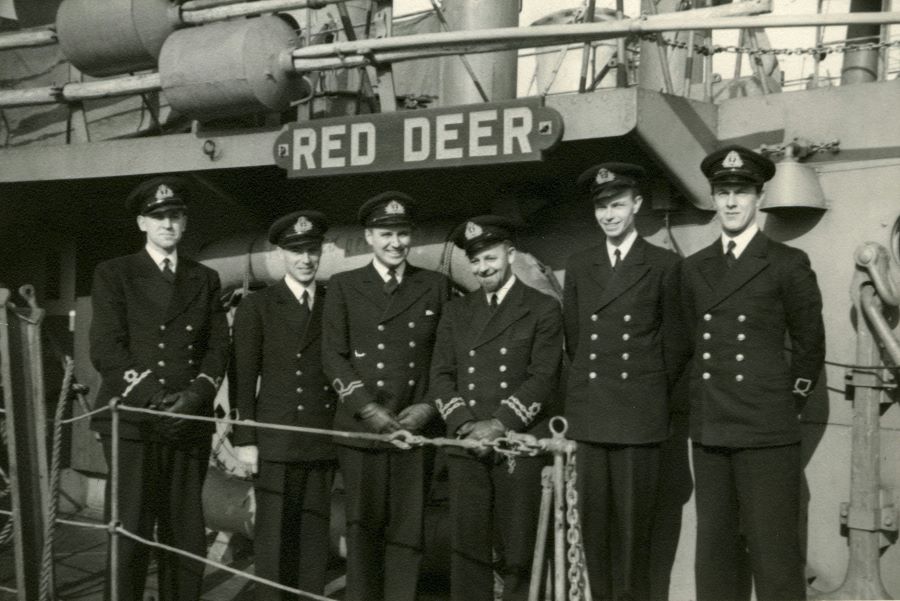|
HMCS RED DEER J255 / 196
Bangor Class Minesweeper
Commissioned at Montreal on 24 Nov 1941, RED DEER arrived at Halifax on 03 Dec 1941. She was assigned to WLEF, later serving at various times with Halifax Local Defence Force, Gulf Escort Force, and Sydney Force. On 12 Jan 1942, she rescued survivors from the British SS CYCLOPS, which was torpedoed and sunk by U-123 125 miles southeast of Cape Sable, the first victim of the epic U-boat campaign off the U.S. east coast. In May 1944, she began a refit at Liverpool, N.S., and was sent to Bermuda to work up late in July. In Feb 1944, she had been allocated to Newfoundland Force, and she continued a member of this force until VE-Day. She was paid off at Halifax on 30 Oct 1945, and laid up at Shelburne, later being placed in strategic reserve at Sorel. Re-acquired by the RCN in 1952, she was never re-commissioned, and was sold in Feb 1959, for breaking up at Sorel.
Photos and Documents Ship's company photos The Ship's Bell
HMCS Red Deer: Minesweeper, Rescuer, Survivor - transcription of article from the Red Deer News
Commanding Officers
They shall not be forgotten
Former Crew Members
Photos and Documents
(CA186) HMCS RED DEER J255 - RCN photo (CA187) Charles Atkins in the bridge window of HMCS RED DEER J255 in St. John's (CA188) Charles Atkins by the ready use ammunition locker HMCS REED DEER J255 in St. John's (CA189) Unknown sailor by the ready use ammunition locker on HMCS RED DEER J255 in St. John's (CA190) Unknown sailor on top of the bridge of HMCS RED DEER J255
(CA191) Unknown sailor by a depth charge on HMCS RED DEER J255 in St. John's (CA192) Two unknown sailors by the ship's work boat on HMCS RED DEER J255. Shoreline of Newfoundland in the back ground (CA193) A quiet day in the radio room of HMCS RED DEER J255 while alongside in St. John's
(CA194) Unknown officer with a woman (possibly a wren) by the bridge Oerlikon of HMCS RED DEER J255. Iceberg and the coast of Newfoundland in the background (CA195) Depth charge exploding astern of HMCS RED DEER J255 (CA196) Looking aft from the boat deck of HMCS RED DEER J255 (CA197) Unknown officer by the ready use ammunition locker on HMCS RED DEER J255 (CA198) Unknown officer by forward gun on HMCS RED DEER J255 in Halifax
From the collection of Charles Atkins, RCNVR
Courtesy of Lorne Atkins
The HMCS Red Deer. (Red Deer Digital Archives, P7540)
HMCS
Red Deer: Minesweeper, Rescuer, Survivor
Editor’s note: This story was originally published November 10, 2016 on an older version of rdnewsNOW.com which no longer exists.
It’s been seventy-five years (82 as of 2023) since a Bangor Class minesweeper bearing our city’s name was commissioned by the Royal Canadian Navy for use in World War Il.
The HMCS Red Deer took to the seas on November 24, 1941 and would go on to serve in the longest battle of the war, the Battle of the Atlantic.
“The ship was built as a minesweeper, but we didn’t have many cases of mines being laid in Canadian waters,” explains Red Deer historian (and now city councillor) Michael Dawe. “It was mainly used as an escort for the convoys that were going around the Atlantic Ocean.”
Not only did the HMCS Red Deer outlast the Battle of the Atlantic, it played a hero’s role on January 12, 1942 near the shores of Cape Sable, Nova Scotia.
The SS Cyclops, a steam merchant, had been sunk by a torpedo from a German U-boat. While an estimated 87 crew members died, the Red Deer rescued 95 others.
Rescue of the survivors of the sinking of the SS Cyclops, Jan. 2, 1942. (Red Deer Digital Archives, P7542)
Former British Prime Minister Winston Churchill once said World War Il would not have been won if it weren’t for the heroic Navy.
“The Battle of the Atlantic was the dominating factor all through the war,” Churchill said. “Never for one moment could we forget that everything happening elsewhere, on land, at sea or in the air depended ultimately on its outcome.”
Dawe says ships like the HMCS Red Deer made it possible for merchant vessels to get supplies overseas.
“The German U-boat activity had been very severe. The Allies were losing just massive amounts of ships and they came up with this idea of convoys where they would go in groups, and there would be escort ships that would go out and try to fend off submarines,” says Dawe. “There was still incredible loss of life, but the losses were much reduced with the success of the convoys.”
Ultimately, the Red Deer would provide escort from Newfoundland in the north to Bermuda in the south.
The HMCS Red Deer also provided surveillance of German U-boats during the battle of the St. Lawrence which was the first time an enemy had inflicted casualties in Canadian inland waters since the U.S. did so during the War of 1812.
Dawe says despite there being only two locals who served on the Red Deer, residents built a strong connection with the crew.
Officers of the HMCS Red Deer. (Red Deer Digital Archives, P7537)
“The community kept in real touch and they sort of adopted the ship. They would send gifts or little parcels to the ship’s people,” he says. “Lt. Arthur Moorehouse would keep the mayor and council and the community informed of what they were doing and it ended up being a very warm relationship.”
Petty Officer Jack Ralston, born in Brandon, Manitoba, eventually became a resident of Red Deer and was the first local recognized as having served on the HMCS Red Deer. His sister Margaret Bedard, who now lives near Vancouver, says the family grew up in north Red Deer.
“When he’d come home on leave, we were big shots because we lived in north Red Deer, and they weren’t always big shots back then,” she quipped.
“He enjoyed being on the boat and he was happy to be in the service. When they’d gone on one rescue, they couldn’t pick up survivors, they just had to plow through them because a German submarine was nearby. He said that was awful not being able to stop and pick them up.”
Following his service, Ralston spent several years working for the District of North Vancouver before passing away in Coquitlam, B.C. in 1986.
Ralston’s cousin, James Layton Ralston, served as Canada’s Minister of Defence from 1926-1930 and again from 1940-1944 while HMCS Red Deer was in action.
Click here to view the complete article on the rdnewsNow website
|
|||||||||||||||||||||||||||||||||||||||||||||||||||||||||||||||||||



